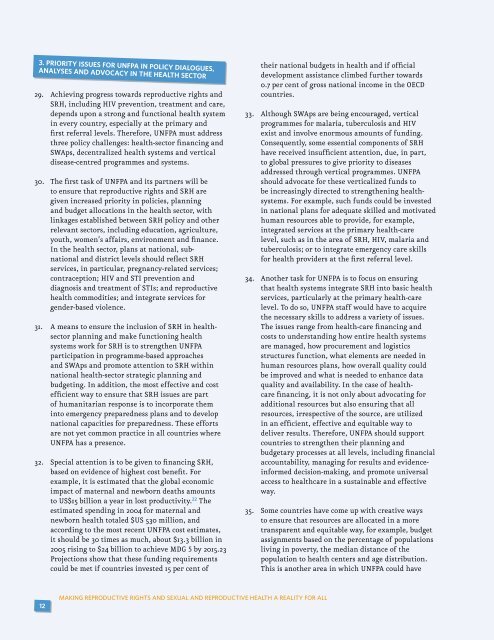Sexual and Reproductive Health Framework - UNFPA
Sexual and Reproductive Health Framework - UNFPA
Sexual and Reproductive Health Framework - UNFPA
You also want an ePaper? Increase the reach of your titles
YUMPU automatically turns print PDFs into web optimized ePapers that Google loves.
3. priority issues for unfpa in policy dialogues,analyses <strong>and</strong> advocacy in the health sector29. Achieving progress towards reproductive rights <strong>and</strong>SRH, including HIV prevention, treatment <strong>and</strong> care,depends upon a strong <strong>and</strong> functional health systemin every country, especially at the primary <strong>and</strong>first referral levels. Therefore, <strong>UNFPA</strong> must addressthree policy challenges: health-sector financing <strong>and</strong>SWAps, decentralized health systems <strong>and</strong> verticaldisease-centred programmes <strong>and</strong> systems.30. The first task of <strong>UNFPA</strong> <strong>and</strong> its partners will beto ensure that reproductive rights <strong>and</strong> SRH aregiven increased priority in policies, planning<strong>and</strong> budget allocations in the health sector, withlinkages established between SRH policy <strong>and</strong> otherrelevant sectors, including education, agriculture,youth, women’s affairs, environment <strong>and</strong> finance.In the health sector, plans at national, subnational<strong>and</strong> district levels should reflect SRHservices, in particular, pregnancy-related services;contraception; HIV <strong>and</strong> STI prevention <strong>and</strong>diagnosis <strong>and</strong> treatment of STIs; <strong>and</strong> reproductivehealth commodities; <strong>and</strong> integrate services forgender-based violence.31. A means to ensure the inclusion of SRH in healthsectorplanning <strong>and</strong> make functioning healthsystems work for SRH is to strengthen <strong>UNFPA</strong>participation in programme-based approaches<strong>and</strong> SWAps <strong>and</strong> promote attention to SRH withinnational health-sector strategic planning <strong>and</strong>budgeting. In addition, the most effective <strong>and</strong> costefficient way to ensure that SRH issues are partof humanitarian response is to incorporate theminto emergency preparedness plans <strong>and</strong> to developnational capacities for preparedness. These effortsare not yet common practice in all countries where<strong>UNFPA</strong> has a presence.32. Special attention is to be given to financing SRH,based on evidence of highest cost benefit. Forexample, it is estimated that the global economicimpact of maternal <strong>and</strong> newborn deaths amountsto US$15 billion a year in lost productivity. 22 Theestimated spending in 2004 for maternal <strong>and</strong>newborn health totaled $US 530 million, <strong>and</strong>according to the most recent <strong>UNFPA</strong> cost estimates,it should be 30 times as much, about $13.3 billion in2005 rising to $24 billion to achieve MDG 5 by 2015.23Projections show that these funding requirementscould be met if countries invested 15 per cent oftheir national budgets in health <strong>and</strong> if officialdevelopment assistance climbed further towards0.7 per cent of gross national income in the OECDcountries.33. Although SWAps are being encouraged, verticalprogrammes for malaria, tuberculosis <strong>and</strong> HIVexist <strong>and</strong> involve enormous amounts of funding.Consequently, some essential components of SRHhave received insufficient attention, due, in part,to global pressures to give priority to diseasesaddressed through vertical programmes. <strong>UNFPA</strong>should advocate for these verticalized funds tobe increasingly directed to strengthening healthsystems.For example, such funds could be investedin national plans for adequate skilled <strong>and</strong> motivatedhuman resources able to provide, for example,integrated services at the primary health-carelevel, such as in the area of SRH, HIV, malaria <strong>and</strong>tuberculosis; or to integrate emergency care skillsfor health providers at the first referral level.34. Another task for <strong>UNFPA</strong> is to focus on ensuringthat health systems integrate SRH into basic healthservices, particularly at the primary health-carelevel. To do so, <strong>UNFPA</strong> staff would have to acquirethe necessary skills to address a variety of issues.The issues range from health-care financing <strong>and</strong>costs to underst<strong>and</strong>ing how entire health systemsare managed, how procurement <strong>and</strong> logisticsstructures function, what elements are needed inhuman resources plans, how overall quality couldbe improved <strong>and</strong> what is needed to enhance dataquality <strong>and</strong> availability. In the case of healthcarefinancing, it is not only about advocating foradditional resources but also ensuring that allresources, irrespective of the source, are utilizedin an efficient, effective <strong>and</strong> equitable way todeliver results. Therefore, <strong>UNFPA</strong> should supportcountries to strengthen their planning <strong>and</strong>budgetary processes at all levels, including financialaccountability, managing for results <strong>and</strong> evidenceinformeddecision-making, <strong>and</strong> promote universalaccess to healthcare in a sustainable <strong>and</strong> effectiveway.35. Some countries have come up with creative waysto ensure that resources are allocated in a moretransparent <strong>and</strong> equitable way, for example, budgetassignments based on the percentage of populationsliving in poverty, the median distance of thepopulation to health centers <strong>and</strong> age distribution.This is another area in which <strong>UNFPA</strong> could have12MAKING REPRODUCTIVE RIGHTS AND SEXUAL AND REPRODUCTIVE HEALTH A REALITY FOR ALL
















